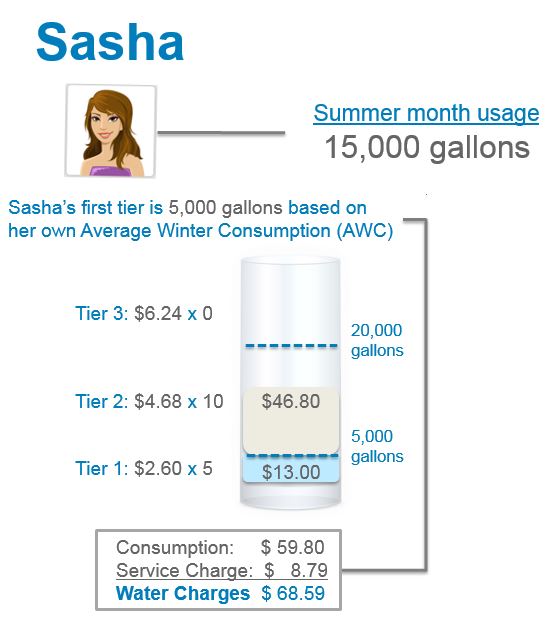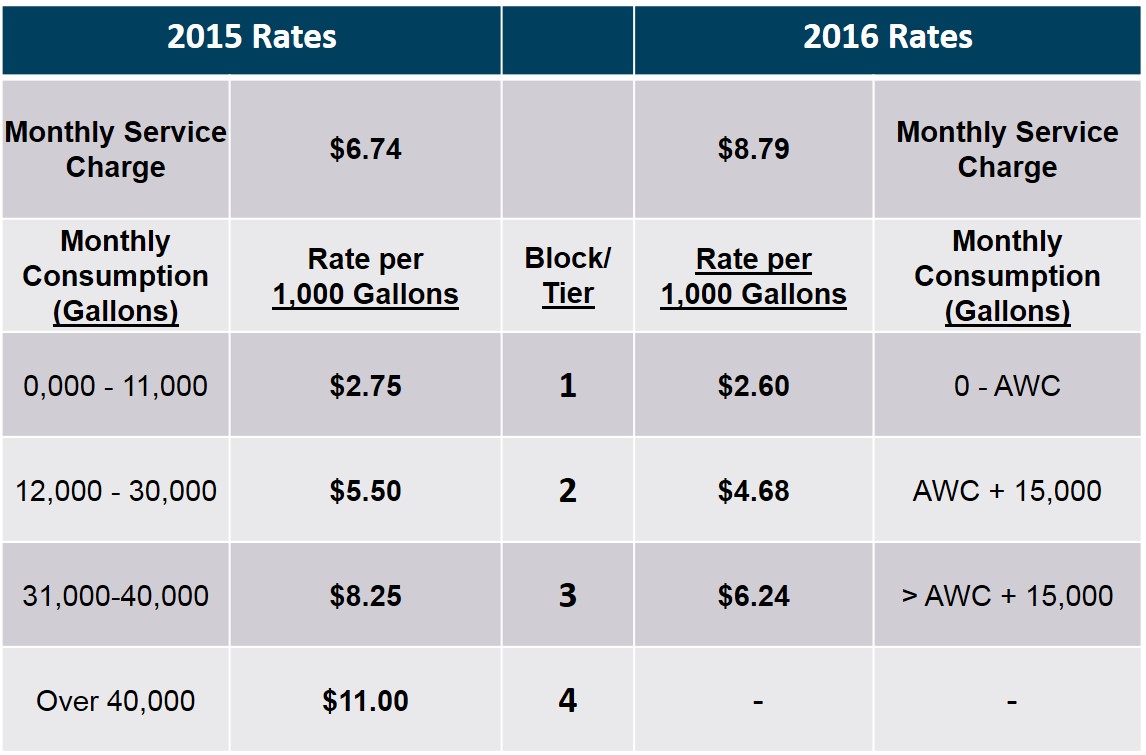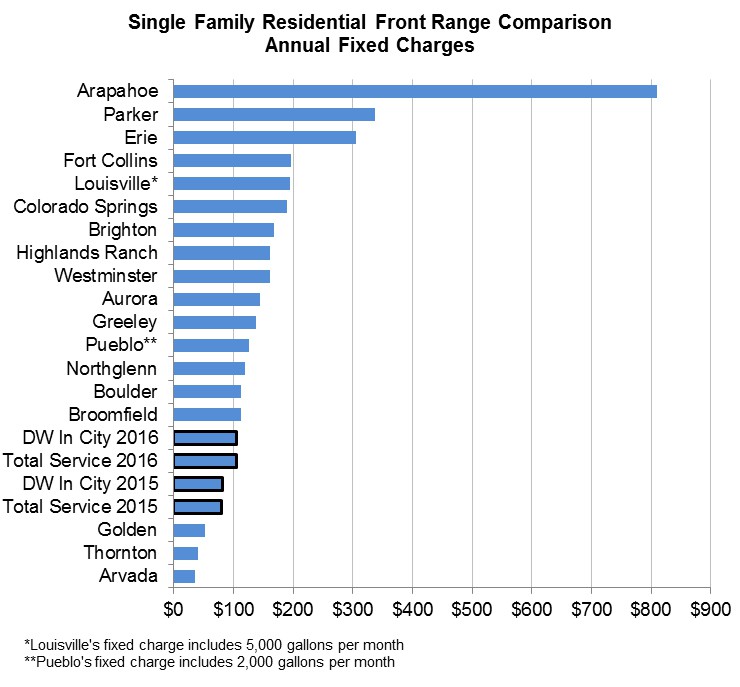
Your water bill: Different path, same goals
Editor's note: These numbers reflect rates for 2016.
Imagine if we encouraged people to use as much water as they wanted, instead of only what they needed.
We’d have more money available to invest back into an aging and critical system that more than 1 million people — and counting — rely on for survival every day.
Alas, we don’t have that luxury. Coloradans know better. We can’t simply produce more water, so we will always have to use this precious resource efficiently — a fact recently underscored by the Colorado Water Plan.
But that reality also wreaks havoc on our cost-of-service financial system.
For the past 20 years, the way we’ve charged for water helped drive home the importance of conservation with one simple notion: The more you use, the more you pay.
We kept our fixed monthly charge very low, with a four-tiered consumption charge that increased with the amount of water you used. So a single-family residential customer in Denver paid $6.74 every month and then would pay from $2.75 up to $11.00 per 1,000 gallons, depending on the amount of water they used in each tier.
But a lot has changed in two decades. Our customers have adopted more efficient water use habits (that’s a good thing), cutting their average consumption by more than 20 percent in the last 10 years. And at the same time, our climate conditions have become far less predictable, creating more frequent, extreme weather. That means our revenue is inconsistent, making it harder to plan for and complete repairs and upgrades to our system.
So here’s the good, the bad and the confusing about your new water bill, coming April 2016:
The good: Three tiers, not four
The focus remains on efficient water use — we don’t have a choice in our semi-arid climate — by keeping a tiered structure that charges more for inefficient use.
Because water used indoors is for cooking, bathing, drinking and hygiene, we consider this to be essential for human life and assign this the lowest rate. So we’ll calculate your indoor use by taking your average winter consumption (when you’re not watering your lawn — we hope) to determine how much water you need indoors. Each month, the amount of water you use up to your average winter consumption will be charged at the lowest rate per 1,000 gallons.
That means, if you live in Denver and your average winter consumption is 5,000 gallons, you’ll pay $2.60 per 1,000 gallons up to 5,000 each month.
We also understand the value of having landscapes for gardens or kids and pets to play on. (It’s the reason we provide tools to help with this.) So customers will be allotted an additional 15,000 gallons — what it takes to water an average-sized yard efficiently — for outdoor use, which falls into a second, higher-priced tier at $4.68 per 1,000 gallons.
Anything above that will fall into the third, highest-priced tier at $6.24 per 1,000 gallons, as this is considered inefficient water use, such as over watering your landscape. The more you use, the more you pay. Sound familiar?
The following chart shows how the price per tier compares this year to last. You’ll also notice that the service charge is higher (more on that in a moment).
So does this mean your bill will be higher or lower? Bottom line: With the new individualized bills, it is completely dependent on how you use water.
The bad: Increases
In the past, when water use was low because of a rainy summer or one filled with drought restrictions, we relied on financial reserves to help make up that deficit. But we’re now seeing multiple years with extreme weather swings, causing more frequent dips in revenue. The result is a less reliable revenue stream for us, resulting in more variable rate increases for our customers.
Here’s the reality: The price to collect, store, treat and deliver water is based mostly on fixed costs. No matter how much water is used, we still need to maintain and operate more than 3,000 miles of distribution pipe, 19 reservoirs, 22 pump stations, 30 underground storage tanks, four treatment plants and much more.
That makes it difficult to keep up with these increasingly common revenue swings.
To provide more stability, we’ve raised the fixed monthly charge on residential water bills to $8.79, up from $6.74. This fee takes into account the stress put on the system, and the cost is dependent on meter size. That means larger, commercial users will be billed at a higher fixed monthly charge.
The higher fixed charge will be balanced out by the new tiered structure, where the cost per 1,000 gallons will actually be less than in the current structure (see the rate structure chart above).
This new structure does not change the fact that the cost to deliver clean, reliable drinking water and provide fire protection increases every year. In fact, next year we’ll need an overall 3.8 percent revenue increase. This increase was factored in when we analyzed and created the water charges for 2016.
The confusing: No two customers are alike
Because the first tier will be based on the amount each individual household uses in the winter, your bill will likely be different than some of your neighbors.
Let’s assume two neighbors both use 15,000 gallons in June. The neighbor with higher outdoor water use (more gallons included in the second tier) will end up paying more for the exact same amount of water. (Remember the emphasis on conservation?)
Even more confusing is that we have different customer classes and types. So when explaining an impact of a rate increase, or a billing structure, we can’t provide a one-size-fits-all number. Everyone is affected differently, depending on your relationship with water.
Change is hard. And we’re not alone. The value and price of water is a much-discussed topic across the nation. And, as our good friends at DC Water explained, communication is vital.
That’s why we’ll keep on talking about this as we get closer to April, when the new billing structure kicks in, from informational pieces in your water bills to more information and tools on our website.
Stay tuned.
Note: Fixed service charge is dependent on meter size and suburban, commercial and recycled customers will see different charges in each tier. See the full rates chart for treated water here.



